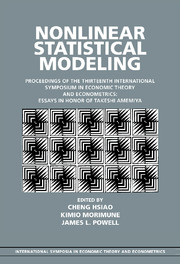 Nonlinear Statistical Modeling
Nonlinear Statistical Modeling Published online by Cambridge University Press: 05 June 2012
Introduction
Often in applied linear regression analysis one must select an explanatory variable from a set of candidates. For example, in estimating production functions one must select among alternative measures of capital stock constructed using different depreciation assumptions. Or, in hedonic analysis of housing prices, one may use indicator or ramp variables that measure distance from spatial features such as parks or industrial plants, with cutoffs at distances that are determined as parameters. In the second example, the problem can be cast as one of nonlinear regression. However, when there are many linear parameters in the regression, direct nonlinear regression can be computationally inefficient, with convergence problematic. It is often more practical to approach this as a linear regression problem with variable selection.
This chapter shows that selecting variables in a linear regression to maximize their conventional significance is equivalent to direct application of nonlinear least squares. Thus, this method provides a practical computational shortcut that shares the statistical properties of the nonlinear least-squares solution. However, standard errors and test statistics produced by least squares are biased by variable selection, and are often inconsistent. This chapter gives practical consistent estimators for covariances and test statistics, and shows in examples that kernelsmoothing or bootstrap methods appear to give adequate approximations in samples of moderate size.
To save this book to your Kindle, first ensure [email protected] is added to your Approved Personal Document E-mail List under your Personal Document Settings on the Manage Your Content and Devices page of your Amazon account. Then enter the ‘name’ part of your Kindle email address below. Find out more about saving to your Kindle.
Note you can select to save to either the @free.kindle.com or @kindle.com variations. ‘@free.kindle.com’ emails are free but can only be saved to your device when it is connected to wi-fi. ‘@kindle.com’ emails can be delivered even when you are not connected to wi-fi, but note that service fees apply.
Find out more about the Kindle Personal Document Service.
To save content items to your account, please confirm that you agree to abide by our usage policies. If this is the first time you use this feature, you will be asked to authorise Cambridge Core to connect with your account. Find out more about saving content to Dropbox.
To save content items to your account, please confirm that you agree to abide by our usage policies. If this is the first time you use this feature, you will be asked to authorise Cambridge Core to connect with your account. Find out more about saving content to Google Drive.